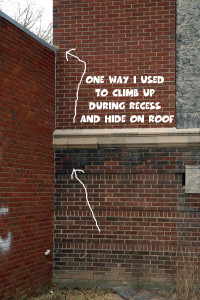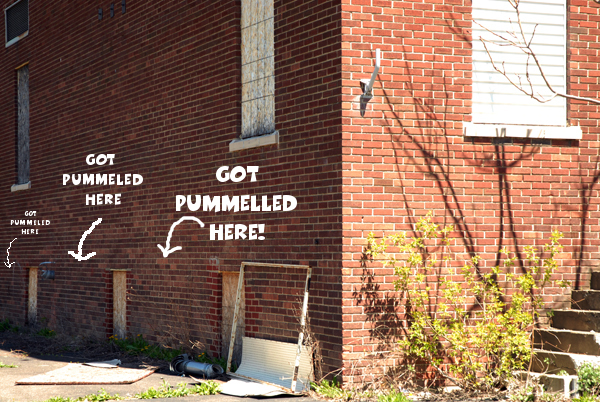“A little talent is good to have if you want to be a writer,
but the only real requirement is the ability to remember every scar.” ~ Stephen King
We all have scars: some physical, some mental, some emotional. Some are deep and dark, others superficial, others in between, but most leave their mark in some way on the person we become (it’s how we respond to the events that caused those scars that often defines us).
I look at my knees and my shins and I know full well that I don’t remember every scar, not all the physical ones anyway (the others tend to be easier to remember, or harder to forget).
There was that one summer afternoon and the banana seat bike at my aunt’s house with its shiny chrome fenders, the bike I tried to hurdle (whatever might have inspired such an act is a mystery). The front fender turned bloody pretty fast and somehow that scar remains on my left shin.
There was the time when I was five or six and I plucked the discarded razor blade (which I was specifically told to stay away from because it was sharp, because it could hurt me) the same razor that had been hidden in a folded Kleenex and stuffed at the bottom of the trash, the razor I tested on my index finger.
Still got that scar to remind me of my youthful curiosity (meaning my flat out stupidity, that is).
I spent a lot of time on the ground as a boy (sometimes playing with my plastic troops and my hot wheels, sure, but most often the result of some outside force acting upon my body – you know, like gravity, or bigger stronger older boys).
I never really thought about it until today, but remembering scars isn’t always bad. Sometimes it can be a lot of fun. For one thing, it’s a chance to give my sister a hard time. And when is that not fun?!? Like now, for example, as I remember the events that led to my propensity for climbing, for being UP. Those events are finding their way into my writing. So, you could say, they’re scars well spent.
Out behind the elementary school where I started my rather long career as a student, there was a humungous (by seven-year-old standards) field where we expelled a lot of energy playing all sorts of games (kickball, baseball, football, tag, and so on).
Although it was only a few blocks from my home, I don’t recall playing in that field except for when we were in school. We usually just played in the street, after all, and as expansive as the field was, I think most of us always associated it with school. Once we were unleashed onto the world each day after the final bell, going back wasn’t an option (unless it was to play basketball in the gym, I wouldn’t have missed that for anything).
One day when I was in second (maybe third) grade, we did all the usual fitness tests (from the school’s perspective physical prowess was determined through a series of athletic endeavors, though in the world of boys there were other factors) and I remember running a race out behind the school one day on that vast field and finishing somewhere in the middle of the pack – well behind two of the girls I had crushes on (one of whom was third fastest in the whole class). Yep. I’m drawing on some of my experiences at that school as I write my new Middle Grade novel Xero Treu: The Extraordinary Tales of an Extra Ordinary Boy.
 The school building itself, for example, a hulking monstrosity of brick and mortar and cement, is making its way into the novel.
The school building itself, for example, a hulking monstrosity of brick and mortar and cement, is making its way into the novel.
The main building was three-stories tall and it had these massive windows made up of three dozen smaller panes. At one end of the building there was a single-story addition, maybe twenty feet tall, where the kindergarten class met. A ledge about ten feet off the ground ran the length of the main building, but it seemed more decorative than anything as it wasn’t flat on the top like the ledges you see in movies. This one was beveled which made walking and sitting atop it especially challenging.
I’ve spent a few decades giving my sister a difficult time about some of the “scars” I acquired back then, accusing her every chance I get, more or less (meaning more, much more), of being the reason behind my frequent pummeling (you know, day after day after day) by three boys in particular who were bigger and stronger and older than me.
Boys who lived across the street from us.
Boys with whom we often spent a lot of after-school time playing (meaning trying to survive, really, trying to keep their minds off the past). Thankfully their memories were extremely short.
The one thing I haven’t done publicly, until now, is thank my sister for those experiences, for some of those scars. So here goes nothing.
I abhor violence. I hate fighting. It makes me sick inside, makes my stomach clench like a fist, my heart race. I don’t recall one time in my entire life when I faced someone one-on-one. As a result of those early mishaps, I was the only second-grader I knew who hated recess.
I used to ask to stay behind, used to hide everywhere possible: in the classroom closet, in other classrooms, under desks, behind the curtains on stage in the gym – that’s right, the gym had a stage – and I was caught nearly every single time, was told I was being silly, was forced to go outside and, you know, meet my doom.
It struck me back then how all the teachers seemed to vanish during recess, one or two occasionally making themselves known, little more than a head craning around a corner, then poof, they were gone again.
Well, I should take that back. They did tend to show up completely after I got pummeled.
You’d think they could do the math. Every day at recess the shy, quiet, overly-polite (or so I’ve been told) boy ends up eating dirt, ends up a mangled mass of legs and arms, a lump on the ground somewhere. I mean, after the tenth time, the twentieth, you’d think they’d have started to catch on to the reasons behind my desire to skip recess.
There were one or two hiding spots, however, where I never got caught.
One of these spots was on the roof of the school (the short roof, not the tall the one). But I was only seven or eight, so it was still a climb.
My experience climbing the walls of that old school, fingers sliding into the grooves, toes of my Chuck Taylors wedged in place, the way I always found some sense of freedom being UP, these elements from my childhood, from my story, are making their way into Xero’s story.
Although some scars are more daunting to remember, more difficult to plumb the depths of, I’ve enjoyed revisiting the scars I acquired back in second and third and fourth grade. I’ve enjoyed revisiting the school where it all happened, quite literally spending some time there, taking photos like the ones found in this post, putting my fingertips half-a-knuckle-deep into those grooves.
Now, truth be told, most of those days that I hid on the roof, I still got pummeled in the end.
I’d hear my sister’s voice somehow above the rest, calling my name, crying out for help, and I’d be off the roof and down the wall and running all out in the direction of her voice (in other words, speeding off toward my own destruction).
I tease my sister often. Of course, she’s earned it through years of hard work and determination. But if not for those experiences Xero might not be a climber of bricks, there might not be a school where Xero meets Knee Boots, a school where Xero’s life changes forever.
Words are a lot like bones. When I write, I’m really trying to create a new me, one that has a certain experience, one who is in the world and sees the world and interacts with the world in ways I never have, maybe even in ways I never could. Of course, sometimes I’m able to take one of the experiences I have had and explore it in completely new ways through my characters.
So, see, little sis. It’s all good!
